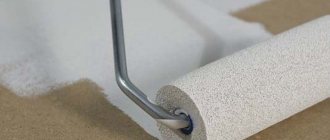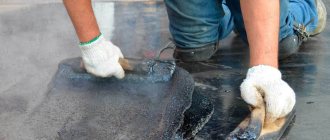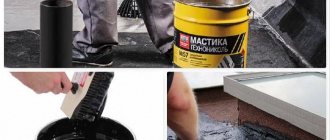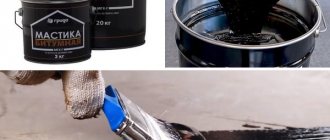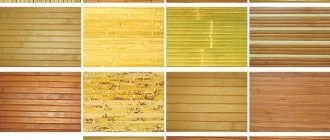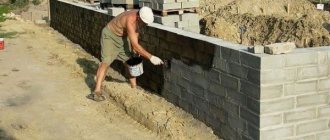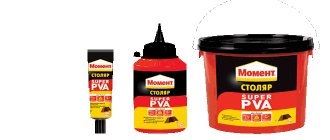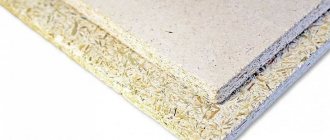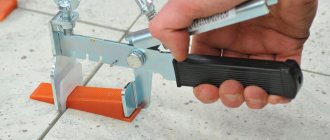Currently, bitumen mastic is being used more often than others to create an insulating layer in construction.
It can be, depending on the method of application, cold or hot. Hot ones are used by professional builders and require the use of special equipment with an open flame for heating, while cold-applied bitumen mastic is easy to use; it just needs to be diluted. The production of mastic occurs from a bitumen base. Bitumen as an independent material does not have good insulating quality, because at sub-zero temperatures it can crack, and at very high temperatures they melt.
Main characteristics
Note: Bitumen is an asphalt concrete product obtained by processing petroleum products. These disadvantages are eliminated thanks to special polymer additives. The result is a surface that perfectly resists temperature fluctuations and external factors. Mastic is distinguished by reliability and durability.
Another important component of this substance is a thickener (chalk, peat chips, ground asbestos). These components make the mastic even more convenient to use, help reduce costs and increase its thermal insulation characteristics.
Note: The main purpose of using mastic is to protect the surface from excess moisture.
As mentioned earlier, cold mastic does not require preparation for use. The composition is simply mixed and applied. It is used mainly in roofing work as a waterproofing layer. It can also be used when repairing the roof, treating the foundation, it is applied before laying roofing felt. Important: Cold mastic is consumed less than hot mastic. Mastic is not susceptible to corrosion processes and is resistant to various negative factors.
Comparative table of properties of bitumen and mastics for various applications
| Cold solvent-based mastic | Cold water-based mastic | Hot mastic | Bitumen | |||
| Options | Roof | Foundation | Roof | Foundation | Roof | Foundation |
| Thickness of 1 layer, mm | 1,0 | 0,5-1,0 | 1,0 | 0,5-1,0 | 2,0 | 1,0 |
| Consumption per 1 layer, kg/m2 | 1,0-2,0 | 1,0-1,5 | 1,5 | 1,0-1,5 | 2,0-2,5 | 1,0 |
| How long does it take to dry at 20 °C and 50% humidity, hours | 24 | 24 | 5 | 5 | 4 | 24 |
| Temperature at which work can be performed, °C | -10 to +40 | -10 to +40 | From +5 to +40 | From +5 to +40 | From +5 to +40 | From +5 to +40 |
| Base humidity no more than, % | 4 | 4 | 8 | 8 | 4 | 4 |
Advantages and disadvantages
Due to the use of simplified technologies in the production of this type of mastic, it is becoming increasingly popular among consumers. Taking this into account, cold-applied mastics based on bitumen are becoming a common material for waterproofing.
Bitumen mastic has a number of positive qualities:
- dries instantly;
- can be used for spot repairs;
easy to use, even a non-professional can handle it;- there is no need to use special equipment for heating, unlike the hot type, which greatly simplifies the process;
- it can work on wood, metal, concrete or plastic surfaces;
- has elasticity;
- upon application, penetrates into the coating structure;
- due to their unique composition they are resistant to atmospheric conditions, temperature fluctuations, and ultraviolet radiation;
- a wide range of colors of mastics is achieved by adding coloring pigments;
- water-based mastics are used for internal insulation of premises.
In addition to the advantages, there are also some negative points:
- the material is flammable;
- High-end cold mastic may cost more than hot mastic.
Hot bitumen plastic
This is a homogeneous plastic mass based on petroleum products and astringent fillers, which is heated to 180 degrees before use. After heating, the mass is applied to a previously primed surface.
Once cooled, the mass becomes a durable, highly elastic coating.
The main advantages of hot bitumen mastic are:
- no shrinkage;
- dense structure;
- Possibility of use at low temperatures.
Among the main disadvantages are the high risk of fires and high labor costs.
Marking
The letter A indicates the inclusion of an antiseptic in the composition of the mass, and B indicates herbicide additives.
Kinds
I distinguish the following types of mastic depending on the added impurities:
- with a polymer base, including modifiers that give the material strength, heat and frost resistance;
rubber, to which crumbled rubber is added;- latex;
- oil;
- rubber, most often used;
- kukersolnaya, which is also called kukersol.
Cold application mastic can also be:
- Solvent-based;
- water based.
When using the first one, there is no need for preparation; the composition is available ready-made. Can be used for waterproofing using the coating method. Can be used even at sub-zero temperatures. Due to the presence of solvent in the mastic and its instant evaporation, a monolithic waterproofing layer is formed.
Cold mastic is mainly used to create a waterproofing layer during roofing work. Note: The drying time of the mastic layer is from 12 to 24 hours, but it acquires its properties after 7 days.
Cold mastic, which is based on water, is also called bitumen emulsion. Its production involves the use of high-tech processes and the latest materials such as polymers and emulsifiers. With its use, roof waterproofing is completely environmentally friendly and safe. After the emulsion is applied to the surface, water begins to evaporate from it and a layer of high-strength waterproofing is formed.
The following advantages of bitumen emulsion are highlighted:
- The most convenient application;
- Because there is no solvent here, it is a completely non-toxic material;
- Can also be used when working inside a living space due to explosion and fire safety;
- Dries quickly.
Perhaps the only disadvantage of bitumen emulsion is that it cannot be stored and worked with at temperatures below plus five degrees, because in a cold environment it loses its properties. This is explained by the fact that when the liquid transforms into a solid state, the emulsion disintegrates.
In terms of composition, mastic can be of two types: one- and two-component. The former exhibit their full properties as a waterproofing coating only after the complete evaporation of the minor component, for example, water. In the two-component version, the properties are demonstrated when 2 elements are added. Basically, this role is played by the hardener.
What is bitumen mastic
The main component of bitumen mastic is oxidized petroleum bitumen. To make it liquid, solvents are added to the bitumen: white spirit, solvent, toluene. After application, volatile solvents quickly evaporate and the bitumen coating hardens. Since it is difficult to use bitumen mastic only with a solvent in its composition, other components are added to it:
- For hardness and heat resistance : dust asbestos, ash, fine powders from brick, quartz, dolomite, talc, limestone.
- For thickness : chalk, ground asbestos, peat chips. Working with bitumen mastic with such fillers is easier. When applied, the composition retains its shape better and does not spread as much, which makes it possible to bring the coating onto an uneven surface into a plane.
- For reinforcement and resistance to bending : mineral wool threads, fiberglass, fibrous asbestos.
In two-component mixtures, the thickener for bitumen mastic is added immediately before use. Two-component formulations last longer and can be used for several months after opening, provided the container is hermetically sealed. Before applying bitumen mastic, the thickener is poured onto the base and mixed thoroughly. It is important to obtain a homogeneous flowing solution, otherwise the bitumen coating will not last long.
Cold and hot bitumen mastic
Mastic brought into a liquid state by solvents is called cold because it does not need to be heated before use. Of course, if the temperature is not lower than +5 °C.
Using cold-type mastic has several advantages:
- Safety . There is no heating, which means there is no risk of burns or fire if the technology is violated.
- Plasticity . Cold bitumen mastics are used to fill expansion joints, since even after hardening they remain elastic and do not crack when squeezed.
- Convenience . Before using cold-type bitumen mastic, you just need to mix it well. The maximum is to add a thickener if it is two-component. In addition, it is easier to apply than heated and quickly cooling bitumen.
- Durability . As a material that is not prone to cracking, cold mastic lasts a long time. Especially if polymer additives are added to it. But more on that later.
Although cold mastic is, in fact, the standard of modern construction, hot compounds are sometimes used. Of course, this is no longer pure bitumen - many fillers and additives are added to it to make the waterproofing coating resistant to mechanical damage and temperature changes. But these fillers do not contain solvents, so before using hot-type bitumen mastic, it must be heated to 150-180 °C.
Before use, hot bitumen mastic is heated
Hot mastics are very inconvenient and dangerous to use due to the risk of serious burns and rapid thickening after removal from heat. But they have their advantages:
- No shrinkage . When solvents evaporate, the volume of cold mastic decreases greatly. There are no solvents in hot bitumen mastic, so after hardening the volume remains the same.
- Dense structure without pores . Again, there are no solvents - no pores that appear when volatile substances evaporate.
- Fast hardening . After laying, the layer of hot mastic completely hardens very quickly. Therefore, the use of hot-type bitumen mastic is optimal in cases where there are only a few hours to structure the waterproofing layer, rather than the allotted day. For example, when repairing a roof during rainy periods.
Due to rapid hardening, hot bitumen mastic is not used for waterproofing large area roofs.
What is bitumen mastic used for?
Now about where bitumen mastic is used. This is a universal waterproofing material that is used at all stages of construction: from installing a temporary fence to re-roofing. When carrying out roofing work, bitumen mastic can perform four functions:
- Waterproofing layer when installing a flat roof. The use of bitumen mastic for waterproofing is a construction classic. If the bitumen coating is the final layer of the roofing cake, it is sprinkled with mineral chips to protect it from ultraviolet rays.
- Adhesive for laying bitumen roofing materials: roll roofing, flexible tiles.
- Filler for expansion joints when pouring cement screed on an existing flat roof.
- Sealant for repair work on roofs made of bituminous materials.
Four uses of bitumen mastic when constructing a roof.
The type of mastic is selected depending on the task.
Types of cold bitumen mastics for roofing
Four types of cold mastics are used for roof waterproofing:
- Unmodified mastic . The simplest and cheapest type of bitumen mastic, which is usually used to repair old roofs or as an additional fixative for a built-up roof.
- Bitumen-polymer mastic . Most often, this type of mastic is used for roofing. Due to polymer additives, the mastic is elastic, durable, very resistant to cracking and temperature changes. It also has excellent adhesion to concrete bases.
- Bitumen-rubber or rubber-bitumen mastic . The addition of synthetic rubber makes the mastic even more flexible and durable, even compared to compositions with polymer additives. Bitumen-rubber mastic is best suited for filling expansion joints and for installing mastic roofing.
- Bitumen-latex mastic . Flexible and elastic two-component mastic with exceptional waterproofing properties - withstands water pressure of more than 1 MPa.
To protect a mastic roof from UV rays, you can use gravel or pebbles.
Some manufacturers add substances to mastics that make the mastic coating more resistant to ultraviolet rays. But this does not mean that a mastic roof can not be protected with mineral coating or sand. The UV stabilizer only slightly increases the service life of areas of mastic roofing that, for some reason, were exposed to direct sunlight. For example, due to the fact that the wind blew the mineral coating off them.
How to distinguish high-quality bitumen mastic from substandard material
Low-quality bitumen mastic is found on the market much more often than we would like. This is due to their specific appearance and origin - many petroleum products are visually similar to each other. Therefore, unscrupulous manufacturers may pass off a composition similar to it as bitumen mastic, which, as a rule, is made from “dirty bitumen.” This “mastic” often contains fuel oil, tar and even very toxic creosote. The waterproofing properties of such a mixture leave much to be desired, not to mention the direct harm to health, at least for the person who will work with the material. And perhaps for all residents of the house.
Bituminous mastic of dubious quality can be recognized by three signs:
- Very low price . The price of high-quality waterproofing mastic is from 2000 rubles per 20 kg bucket. Sometimes you can find discounted offers for 1,500 rubles. Low-quality bitumen mastics are many times cheaper: 500-800 rubles, sometimes even 300-400 rubles per 18-20 kg bucket.
- Heterogeneity . High-quality bitumen mastic is a viscous liquid with a silky sheen. If the mixture is made from “dirty bitumen”, it will be lumpy, divided into fractions and, as a rule, with dark gray shades in color.
- Strong specific smell . The most difficult criterion that can be used by those who know what ordinary bitumen mastic smells like. Tar, especially with creosote, has a much stronger odor.
Any of these signs should alert you. But even if you bought a branded expensive mastic, you shouldn’t relax - there are fakes. Therefore, before using bitumen mastic, be sure to print the bucket and check its contents. If the smell and, especially, the appearance of the mixture is suspicious, do not use it for waterproofing; it is better to buy mastic from another manufacturer and from another seller.
Where is it used?
There are some recommendations for using mastics:
- Mastic with a base of kukersol varnish is most suitable for the construction of concrete structures;
- Mastics with a rubber base perform better as a waterproofing layer, due to the composition with rubber, which has good elastic and flowing properties;
- For the installation of roofs, solutions with polymers and rubber bases are chosen;
- Where spot application is required, an oil composition is used, since this composition forms the most highly resistant coatings to temperature changes.
Mastic is used:
- For roofing work;
- As a protective layer for roofs against UV rays and a reinforcing layer when installing tiles;
- In the construction of foundations, basements, piles;
- As protection against foundation corrosion, as well as when gluing heat-insulating material;
- When installing waterproofing in bathrooms, toilets, balconies or garages.
Brands of bitumen waterproofing mastics
In our catalog you can choose and buy bitumen mastics for waterproofing work of the following brands:
- MBG;
- MBGR;
- MBI;
- MBPK-G-75;
- MBU;
- MBR-G-90;
- MGH-G;
- MGH-P;
- Bitumen-latex mastic.
For more information about a particular brand of waterproofing mastic, see the product description at the link or ask our managers.
Application Features
The main feature of cold mastic is its complete readiness for use.
Step by step application:
- The surface under the waterproofing layer is cleaned of contamination;
- Then it is treated with a special primer;
Note: Bitumen primer is often used for waterproofing concrete surfaces, cement screeds, and roofing.
- Then the mastic is mixed well;
- Applying mastic. This can be done using special devices or using the pouring method. Once the mastic is applied, it is smoothed out well. For greater efficiency, it is better to apply the mastic in two layers, each of which does not exceed one and a half millimeters. The next layer is applied only after the first has dried;
- Next, the roll materials are glued.
Important: According to safety rules, mastic is not recommended for use in rooms that do not have an effective ventilation system. And also, its use near open fire is prohibited.
Price
The prices shown in the table are valid in spring 2022:
| Brand | Price in rubles |
| TechnoNIKOL (rubber) 10 l | 900 |
| GIDRIZ-K 10 l (emulsion, modified) | 839 |
| Decken (unmodified) 1 kg | 49,5 |
| Gidroizol (polymer-bitumen) 5 kg | 760 |
| Mastic (unmodified) 16 kg | 295 |
| Lantrek Kraskoff LLC (rubber-bitumen 20 kg) | 820 |
TechnoNIKOL bitumen mastic is a high-quality waterproofing coating from a domestic manufacturer
Nuances of proper operation
When mixing cold-curing mastic, you can notice its ability to liquefy. Thanks to this property, it is easy to work with. Mastic is practically not applied mechanically, and this material is not suitable for spraying, since the composition is viscous. That's why they use a roller here. If the mastic composition is liquid, then it is better to apply it with a brush.
Important: Insulating materials must be stored under certain conditions, namely in strict tightness without access to air.
If the mixture is left in an open container for a day, it will harden and become unusable. When working in the cold season, the mastic is first heated to fifty degrees. However, with high humidity and temperatures less than plus five, even with a heated composition it will not be possible to work. It would be better to postpone all work until favorable conditions.
Does mastic have any disadvantages?
There are not many disadvantages of bitumen mastics. And even the existing disadvantages are more of some limitations in application that are encountered in rare cases. So, among the disadvantages there are:
- The need to apply on a flat surface, otherwise the liquid substance may flow to one side. To reduce the fluidity of the substance, thickeners and cement are used. It is important to carefully prepare a surface with pits and tubercles and smooth out all defects.
- Cannot be used during rain. Water-based mastics also cannot be used at subzero temperatures.
- Difficulties in controlling the thickness of the applied layer, which may increase the consumption of bitumen mastic .
Tips for selection and application
The market leader is cold bitumen mastic produced by TechnoNIKOL. It is offered in a wide variety at an affordable price. However, you should not rely only on materials from this manufacturer for insulation work.
It is necessary to carefully study the range of materials offered in the store and make a choice in favor of the option with the best ratio of performance characteristics and price.
It has already been said above that to solve the problems of insulating concrete pavements, it is best to use bitumen-kukersol solution , which copes with this task perfectly.
If the task is to arrange high-quality waterproofing, then when searching for materials you should choose rubber-based mastics or those containing derivatives of this material. An excellent choice for providing reliable waterproofing is waterproofing bitumen cold mastic or something similar.
The main feature of these mastics is their high elasticity and good fluidity. When performing roofing work, you should choose materials made from latex or rubber.
If you choose cold mastic intended for roofing , then you need to be prepared for the fact that the price for it will be quite high. However, when used, you can count on creating a coating that will be durable and reliable, will last a long time and its structure will not change under the influence of environmental factors.
When oil mastics are used during work, a coating is formed on the insulated surface that is resistant to temperature. Therefore, this material is an ideal solution for work when it is necessary to insulate joints on the roof.
